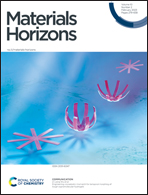Metallogels: a novel approach for the nanostructuration of single-chain magnets†
Abstract
In this study we demonstrate that single-chain magnets (SCMs) can be assembled in gel phase and transferred intact on surface. We take advantage of a family of SCMs based on TbIII ions and nitronyl-nitroxides radicals functionalized with short alkyl chains known to form crystalline supramolecular nanotubes interacting with heptane acting as crystallizing solvent. When the radicals are functionalized with long aliphatic chains a robust gel is formed with similar structural and functional properties respect to its crystalline parent. Indeed, a small-angle X-ray scattering (SAXS) study unambiguously demonstrates that the gel is made of supramolecular nanotubes: the high stability of the gel allows the determination from SAXS data of precise nanotube metrics such as diameter, helical pitch and monoclinic cell of the folded 2D crystal lattice along the tube direction. Additionally, static and dynamic magnetic investigations show the persistence of the SCM behavior in the metallogel. Last, on-surface gelation provides thick films as well as sub-monolayer deposits of supramolecular nanotubes on surface as evidenced by atomic force microscopy (AFM) observations. This paves the road toward magnetic materials and devices made of SCMs profiting of their isolation on surface as individual chains.



 Please wait while we load your content...
Please wait while we load your content...